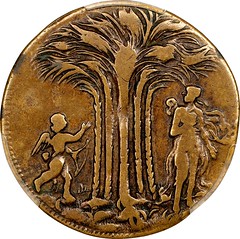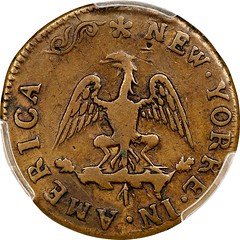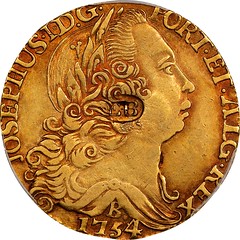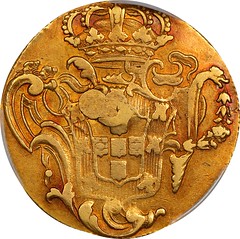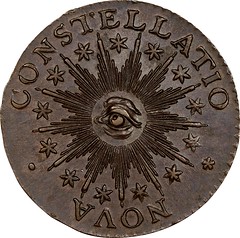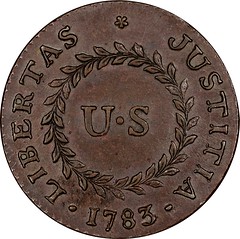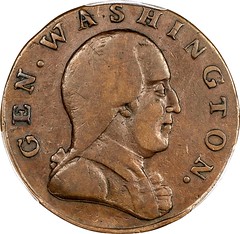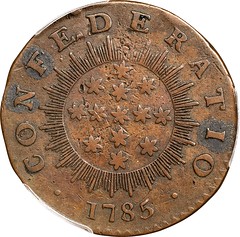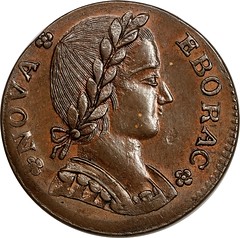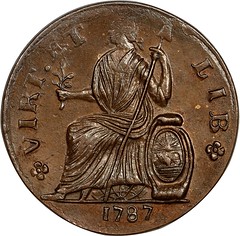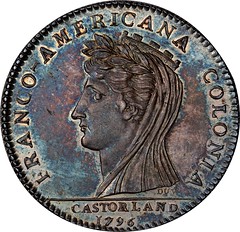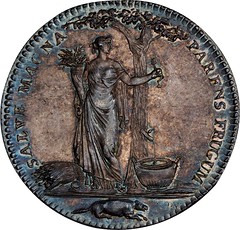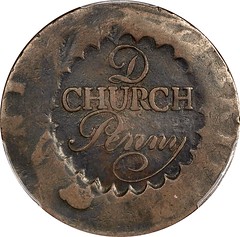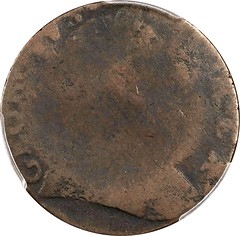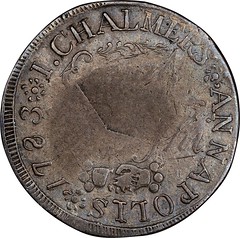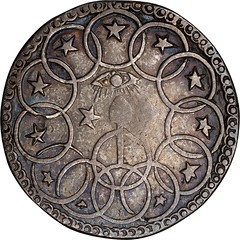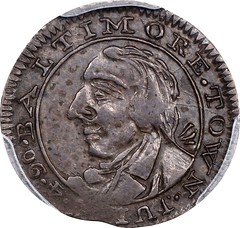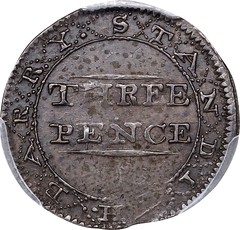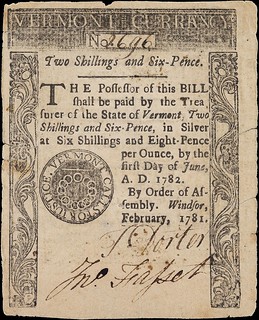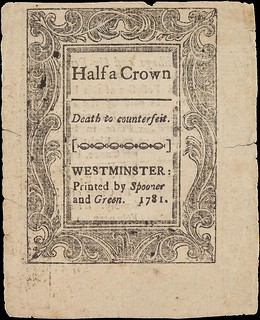
PREV ARTICLE
NEXT ARTICLE
FULL ISSUE
PREV FULL ISSUE
MORE MARTIN COLLECTION PART III HIGHLIGHTSHere are more highlights from the upcoming Stack's Bowers sale of the Syd Martin Collection, Part III. Great collector, great collection. -Editor
The Richard Picker New Yorke in America Token
Undated (ca. 1670) New Yorke in America Token. W-1705. Rarity-6+. Brass. VF-30 (PCGS). 46.9 grains. Acquired in our sale of October 2018, when this piece was described as follows: "A thoroughly appealing example of this highly elusive early American token, thought to have been struck on behalf of Governor Francis Lovelace of New York. In fact, this piece is a perfect match to the Roper specimen that we (Stack's) offered for sale in 1983. Both sides are nicely centered in strike with handsome antique golden-brass patina throughout. A splash of slightly warmer copper toning is evident over the lower left reverse, a tiny dig in the field below the letter N in NEW also serving as a useful identifying feature. Attractive in all regards with solid technical quality, an impressive provenance further enhances the desirability of this important rarity. The New Yorke in America tokens were likely struck in the Low Countries, and their fabric closely resembles the English and Dutch tokens of the third quarter of the 17th century. According to John Kleeberg, author of the most definitive study of this type, the obverse shows a scene of Cupid and Psyche that is a rebus for the name of New York colonial governor Francis Lovelace. "The reason these pieces were struck is unknown, though they could be marketing pieces (something like the Franco-American jetons of the 18th century), or tokens intended for use at Lovelace's King's House tavern in Manhattan, or perhaps even an attempt at a small change medium for New York City. The fact that none have been recovered archaeologically in America doesn't mean much, as most of 17th century New York City was gone by the American Revolution and almost nothing from that era has been dug in modern times. Given that nearly all show significant circulation, and at least a few are holed, they certainly saw some kind of use and are not just patterns or pieces de caprice. "Their mystery adds to their romance, but one fact is certain: these are the earliest coin-like objects to include the words 'New Yorke.' According to the census compiled by John Kleeberg and published in the ANS COAC volume 'Money of Pre-Federal America,' 1991, only 19 examples in brass are known. At least a few new specimens have been discovered since that paper was published, but overall this issue is at least Rarity-6+ with roughly 20 examples known. Ranked 25th in the Katherine Jaeger and Q. David Bowers book 100 Greatest American Medals and Tokens. This particular specimen is the plate coin in Walter Breen's Complete Encyclopedia of U.S. and Colonial Coins."
To read the complete lot description, see:
Important Ephraim Brasher Regulated Half Joe
(ca. 1784) New York. Ephraim Brasher (EB) Regulated Brazil 1754-B 6400 Reis. AU-53 (PCGS). 181.0 grains. Neatly plugged at center from back to front, with a substantial gold pin pushed through a drilled hole and peened flat to the left at central reverse. An EB in oval punch of Ephraim Brasher (the identical punch used on the famous Brasher doubloons) was carefully applied at the central obverse. The edges have been carefully clipped circumferentially to the tops of the legends and a false vertically reeded edge device has been applied to cover the clipping. When Brasher regulated this coin (to the 1784 Bank of New York standard), it would have weighed 216 grains. In its later life as a useful coin, probably while in or bound for the West Indies, more weight was taken off to meet lower island standards and provide a profit for the clipper. The surfaces are richly toned in bold magenta and coppery tones around the devices and peripheries, an eye-catching contrast to the dominant rich yellow gold. Some sparse hairlines are seen, but no serious marks. This is a beautiful example. For an entire generation of scholars, this was the coin that introduced them to the phenomenon of regulated gold coins. After acquiring this piece in a 1913 B. Max Mehl sale, Waldo Newcomer chose it - from one of the most impressive and enormous cabinets in the country - to be among just five pieces he loaned for display at the 1914 ANS Exhibition. The others were also of the highest importance: a silver Continental dollar, a Getz half dollar in copper, a silver Myddelton token, and a Standish Barry threepence. The next year, when the 1742-dated Brasher Lima-style doubloon was discovered by Newcomer, this coin became a reference touchstone. When Wayte Raymond, William Woodin, and Edgar Adams (collectively, the American Numismatic Society's Committee on United States Coins) was asked to rule on the new Lima-style doubloon's authenticity, they cited this exact coin. "The counterstamp E B was added after the piece had been struck," they wrote in the American Journal of Numismatics, "and seems to be exactly like the stamps of this assayer which have been examined on the various Brasher doubloons and other gold coins, usually of Spanish or Portuguese origin, which have appeared from time to time." They noted on the following page "Mr. Newcomer has a piece in his collection, of the same denomination, but dated 1754, also bearing the E B counterstamp on an inserted plug of gold." That was this coin. In Walter Breen's seminal ANS paper "Brasher and Bailey: New York Coiners," published in 1958 at the peak of his numismatic powers, he noted: "[The] assays of foreign gold coins immediately suggest an explanation for the fairly often reported gold coins with the countermark of EB in oval, often on center plug … a Brazilian half dobra of 1754 (Bahia mint), from the Newcomer collection, appeared on pl. 13 of the catalogue of the Society's Exhibition of U.S. and Colonial Coins, January 1914."
To read the complete lot description, see:
Lovely Mint State Crosby 2-B Nova Constellatio
1783 Nova Constellatio Copper. Crosby 2-B, W-1865. Rarity-2. CONSTELLATIO, Pointed Rays, Small U.S. MS-62 BN (PCGS). Provenance: From the Sydney F. Martin Collection. Earlier from Lyman Low's sale of January 1908, lot 283; Hillyer Ryder to F.C.C. Boyd; F.C.C. Boyd estate to John J. Ford, Jr.; our (Stack's) sale of the Ford Collection, Part V, October 2004, lot 35.
To read the complete lot description, see:
Historic 1785 Washington Confederatio Rarity
1785 Gen. Washington / Confederatio Copper. W-5645, Baker-9, Musante GW-03, Breen-1125. Rarity-7+. Large Circle. VF-30 (PCGS). 128.0 grains. 135 degree die rotation. A special Confederation-era copper, combining the famous Maris 4 obverse die and a rare 1785-dated Confederatio obverse that makes this coin a pattern of great historical importance, a preeminent early American Washington portrait, and a New Jersey copper related rarity. There appear to be just six of these. Anton's is a bit better; see the Breen Encyclopedia image. The Ford piece is similar to this one. The others are inferior: Roper's had edge issues, Garrett's was worn and rough, Norweb's was charmingly slick. Roper's reappeared in Partrick (Heritage, 1-2015:5641) as NGC AU-50, but we like this one better. It brought $129,250 the first time around and a little less a year later. The rumored specimen at the Massachusetts Historical Society is an obverse electrotype shell (thanks to Neil Musante for this information). As we noted when we sold Syd's Maris 4-C, a product of this obverse die and a New Jersey copper reverse: "The Maris 4-C Washington Bust copper is the earliest American medallic portrait of George Washington. It is at least four years earlier than the 1790 Manly medal. It's three years earlier than the Washington Before Boston medal. The 1778 Voltaire medal, struck in England or perhaps France, precedes it, but with a fictional portrait that serves only as a stand-in to recognize Washington the concept rather than Washington the man. Only the 1786-dated Non Vi Virtute Vici coppers rival this one, though the marriage of this die to a 1785-dated Confederatio reverse necessarily offers this type an edge in terms of temporal primacy. Compared on the basics of aesthetics alone, this is clearly the preeminent American medallic portrait of Washington from the pre-1790 era, not only the first."
To read the complete lot description, see:
Exquisite 1787 Nova Eborac Copper
1787 Nova Eborac Copper. W-5755, Breen-986. Rarity-3. Medium Bust, Seated Figure Left. MS-64+ BN (PCGS). The only finer examples of the Medium Head variety (with either reverse) graded by PCGS are the Norweb-Partrick coin (MS-66 BN) and the remarkable Newman coin (MS-64+ RB). We sold the Newman coin in our November 2019 sale for $48,000. While there is a small gathering of lower end Mint State examples of the Nova Eborac type, many (even most) show soft strikes, granular surfaces, poor originality, or all of the above. Though the Nova Eborac coinage was unofficial, the mintage was clearly fairly large. It's surprising there aren't more nice ones around, but there just plain aren't. Provenance: From the Sydney F. Martin Collection. Earlier from New York Coin and Stamp Company's sale of the Lorin G. Parmelee Collection, June 1890, lot 461; Hillyer Ryder to F.C.C. Boyd; F.C.C. Boyd estate to John J. Ford, Jr.; our (Stack's) sale of the Ford Collection, Part II, May 2004, lot 298; Lawrence R. Stack Collection, November 2006.
To read the complete lot description, see:
Superb Original Castorland Medal
1796 Castorland Medal. Silver, Original. W-9100, Breen-1058. MS-64 (PCGS). Reeded edge. Coin turn. 226.8 grains. A really spectacular original Castorland medal, displaying spectacular aesthetic appeal and superb technical preservation. Flashy, reflective surfaces show bright pastel blue toning, more subtle violet-gray, and hints of gold over the lustrous silver surfaces. The strike is well centered and crisp, with all details fully realized. Some minor hairlines are seen, but no significant problems are detected under magnification. The eye appeal and originality are both superb. The usual focus of attention while studying the die state of an early Castorland medal is the right handle of the sap pot sitting at the base of the tree. Spalling, a chipping away of the steel die surface, manifests there first, well before any die cracks evolve. The spalling is visible on this piece, but in an early state, considerably earlier than the silver piece that follows, but not as early as either the first copper or the silvered copper specimens in the Martin Collection. The reverse cliche, likely created before the die was even hardened, is an important text representing the earliest die state. These dies clearly proved popular at the Paris Mint after their initial execution by Duvivier in 1796, and the original dies were restruck for collectors from nearly the day they were deposited until the dies fell apart. The reverse die went first, but the obverse lasted well past the midpoint of the 19th century. These reeded edge silver pieces are considered the essence of what a Castorland should be: coin like (thanks to their reeded edges), often showing circulation, struck contemporary to the intended settlement at Carthage, New York. A typical grade of EF or AU is sufficient for most collectors. Examples this nice are both special and rare.
To read the complete lot description, see:
Impressively Overstruck Albany Church Penny
(1790) Albany Church Penny. With D. W-8500, Breen-1170. VF-35 (PCGS). 110.8 grains. Perhaps the most eye-catching example of this rarity known, with more visible undertype than any other specimen known to us. While other examples show evidence of an undertype (typically either a counterfeit George III halfpenny or a well-worn William III halfpenny), none approach this one. The Church Penny obverse is struck, boldly and completely, on the reverse of a counterfeit George III halfpenny, oriented with its 12 o'clock position around 7 o'clock of the overstrike. The exergue line is clear, as is Britannia's head and most of BRITANNIA. On the blank reverse, much of the king's portrait is still visible, as is GEORGIVS and REX. The D on this variety represents the common abbreviation for penny. Not only did the church succeed in remonetizing coppers that were too low in weight to recirculate as halfpence, but by selling them at 12 to a shilling, they successfully turned them into pennies, thereby more than doubling their money. This variety with the D is about as rare as the variety without. Only a handful of better examples exist, but we see (for instance) the finest certified by PCGS is both incompletely struck and has no visible undertype. All things considered, we might prefer to have this one. Syd did too.
To read the complete lot description, see:
The Mickley-Bushnell-Parmelee-Ford Chalmers Rings Shilling
1783 John Chalmers Shilling. W-1795, Breen-1010. Rarity-7+. Rings. VF-35 (PCGS). One of the most important of all early American coins: the finest known example of the Chalmers Rings shilling, struck in 1783 when Annapolis was the national capital, and the Founding Fathers were meeting within sight of Chalmers' mint. The Chalmers Rings shilling stands out among early American coins for several reasons. Its rarity is an obvious one - only five specimens are known (one essentially uniface, another holed). It almost never appears at auction; between 1921 and 1980, not a single specimen was sold publicly, and after three sales in the early 1980s (including two in two weeks!), there was not another offering until 2004. Its denomination is unique among Confederation-era American coins, shared with the more common Worm Shilling types that followed this one. And, perhaps most vitally, it represents the very earliest appearance of the famous linked rings motif on an American coin, predating the ca. 1783 Continental dollars and the 1787 Fugio coppers. Beyond all of this, it shares a remarkable history with the other coins of John Chalmers, struck in the temporary national capital as the nation's leaders ratified the Treaty of Paris literally down the street. In the 1921 John Story Jenks sale, while cataloging the second finest known example (Garrett-Partrick), the Chapman brothers referenced this coin: "Bushnell's went to Parmelee, and S.H. and H. Chapman purchased it there, but I do not recall to whom we sold it." It went into the Brock Collection and did not see another public auction appearance for 114 years. In 2004, when this was offered in our Ford sale, Part II, it was the first opportunity to buy a Rings shilling since 1983, the year two examples hit the market (in the Roper and Lauder sales, in successive weeks that December) and one example was permanently taken off the market when the Norwebs included theirs in a donation of 52 colonial coins to the National Numismatic Collection.
To read the complete lot description, see:
1790 Standish Barry Threepence
1790 Standish Barry Threepence. W-8510, Breen-1019. AU-55 (PCGS). In his groundbreaking March 2010 article in The Colonial Newsletter, Max Spiegel listed this as third finest of 18 specimens he identified, trailing just the Ford coin and the untraced Jackman (1918) coin, which has been said to be at the Maryland Historical Society. He followed this piece in his census with the 1976 ANA Sale coin as fourth best (sold in our October 2018 Archangel Collection sale as PCGS MS-62) and the Eliasberg coin (sold by Heritage in April 2021 as NGC MS-62 and again in August 2021 as PCGS MS-61 for roughly 50% more) as fifth best. The only other example of comparable quality sold in recent years was the Garrett / Breen Encyclopedia plate coin, ranked seventh by Spiegel, which sold without benefit of its Garrett provenance in the May 2022 Heritage sale of the Dittmer Collection as AU-58 (NGC). This silver token threepence is an anomaly in the early American coin series. It's struck in silver, which makes it an oddity after the 17th century. It displays a portrait of someone other than George Washington or an allegorical figure (only the famous George Clinton copper is comparable, and Clinton remains far better known than Calhoun). It bears the most precise date in the entire American series (July 4, 1790), and perhaps most important, was struck after the U.S. Constitution gave exclusive rights to coinage to the Federal government. Spiegel posited that the July 4, 1790 date was intended to align with Thomas Jefferson's Plan for Establishing Uniformity in the Coinage, Weights, and Measures of the United States, which shared that exact same printed publication date. Based on the weights Jefferson suggested for a dollar (376 grains), three pence of Maryland's money of account would weigh pretty much dead on what a Standish Barry threepence weights. As supporting evidence, the Chalmers shillings were struck to a weight standard that made them honest-to-goodness Maryland shillings, based on Maryland's statutory coin valuations and the observed fineness of Chalmers' silver.
To read the complete lot description, see:
Spectacular Quality 1781 Vermont Note
Vermont. February 1781 2s6d. VT-3. PCGS Currency Very Fine 30. #2696. Two pen signatures. One of the very finest known examples of Vermont's first paper money issue, used as the feature plate note in the fifth edition of Eric Newman's Early Paper Money of America, 2008. That any Vermont currency survives is amazing. It was printed on thin paper from second-hand equipment in a third-rate town. (Westminster is lovely, but even today it doesn't merit an exit off adjacent I-91.) Most survivors are fragments; in fact, the vast majority of what passes for a Vermont note in today's marketplace are reassembled Frankenstein-like pastiches. This one is a most unusual exception. The note is intact, never separated, never rejoined, never repaired. A few minor marginal splits are seen, along with a chip at the upper border. The longest of the splits reaches as far as the interior limit of the left border cut. An area of thinning to the lower left of F in "February" appears to be as made. The signatures are bold, the printing is complete and even, and the eye appeal is uncommonly good for any note of this grade. This was the best Vermont in F.C.C. Boyd's remarkable collection of these notes, rivaled only by his Vermont Three Pounds that brought $48,300 almost 20 years ago.
To read the complete lot description, see:
To read the earlier E-Sylum articles, see:
Wayne Homren, Editor The Numismatic Bibliomania Society is a non-profit organization promoting numismatic literature. See our web site at coinbooks.org. To submit items for publication in The E-Sylum, write to the Editor at this address: whomren@gmail.com To subscribe go to: https://my.binhost.com/lists/listinfo/esylum All Rights Reserved. NBS Home Page Contact the NBS webmaster 
|
